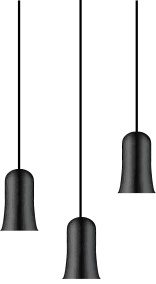

Every area in the house needs proper lighting, however, the kitchen requires it the most. A kitchen’s utility and aesthetics may be improved with thoughtful designed lighting. Modern LED lighting is always a better choice because it uses less energy and is thus less expensive. When used, it doesn’t become hot, which can be a safety problem when lighting is built into cabinets. It also provides good illumination.
Almost any kitchen cabinetry may have lights added to it using one of the several application methods that offer warm, cold, and coloured light options. See how your kitchen could be improved by using these cabinet lighting suggestions.
This kitchen’s overhead lighting shines up toward the ceiling, giving the room a regal appearance. As opposed to when there are no lights and only black shadows above the cabinets, the ceiling immediately appears taller. Strip lighting is a great choice since it produces an uninterrupted stream of light in this situation.
Tip: You have two options for controlling the lights: either hardwire them to a switch adjacent to the one for the ceiling lights or connect them and use a hand sensor beneath the above cabinets.
If you’re adventurous enough, you may add colour to an all-white kitchen by choosing coloured LED lights, which can be switched from white to yellow, red, or green.
To draw attention to an intriguing back panel on an island bench, LED strip lighting or LED downlights can be connected to the bottom of the overhang. This lighting is not meant to be used as task lighting; it is just meant to be ambient lighting. These lights can be used to provide a dramatic impression in the kitchen, especially after turning off the room’s primary work lighting at the end of the day.
Tip: Put the lights on a dimmer, which can be controlled remotely or by a switch next to the lights, to dim or brighten them in accordance with the situation and the atmosphere you wish to set.
Task lighting and ambient lighting are both produced by under-cabinet lights. A far more convenient environment for food preparation is created with under-cabinet illumination that also lights the work surface.
Tip: Under-cabinet lighting should always be placed on a hand sensor switch that is placed where you are most likely to stand when working at the bench. As a result, you can turn on the lights fast and simply when you need them. When your hands are smeared in flour or a sticky mess, a hand sensor also removes the necessity to touch a button or switch.
In a kitchen, glass door cabinets are a terrific area to show off valued collections of china, decorative objects, and glassware. Add additional lights within the cabinets to the displays to give them more punch. A downlight should be placed at the top of the cabinet, and products should be displayed on glass shelves. Light will be able to pass through the glass shelves all the way to the lowest shelf.
Tip: A similar idea may be used with open-shelf units, but keep in mind that the lighting will draw attention to fingerprints and dust on the crockery and shelves. Glass-fronted doors assist in dust reduction.
Kickboard lighting gives the appearance of having greater floor space, especially when combined with a reflecting floor. Hence, a low-profile LED strip is an ideal fixture to employ. In order for the individual LED diodes in the strip to be less obvious in the reflection on the floor, place them within a diffuser.
Tip: These lights may also be mounted on a dimmer switch in order to make it simple to change their brightness. The cupboards in this kitchen nearly appear to be floating above the floor due to the kickboard lights.
When building a new kitchen, several customers prioritize features like a walk-in pantry and an appliance centre. This cabinetry is made more user-friendly and the contents are more apparent with the installation of some LED strip lights on the top.
Tip: To guarantee that the light would shine to the bottom of the cabinet, the shelves must be placed back somewhat and the strip light positioned toward the front of the cabinet. Consider mounting your pantry lighting on a door sensor to turn the lights on when the doors are opened and off when they are closed without the use of a switch.
This is lighting at its most opulent. While not necessary, in-drawer lighting increases the wow factor while making goods inside the drawer more apparent. This is especially helpful in deep drawers or utensil drawers with a variety of items. Additionally, cabinets with interior carcasses that are black or very dark in colour benefit greatly from their installation. These lights typically turn on when the drawer is opened and turn off when the drawer is closed.
Tip: Consult your cabinet designer to see whether such lights are suitable with the drawer hardware they provide and whether any modifications to the cabinets are necessary to create room for them.
Adding impact via lighting in the kitchen is arguably the most dramatic and expensive method to do it. Semi-precious stone onyx may be used for numerous things, including wall panelling, splashbacks, and bench tops.
Tip: The innate translucency of many (but not all) onyx benchtop designs allows for backlighting. Based on the color of the stone, choose cold or warm light for the lighting, and think about using a dimmer switch.
These were some of the best kitchen cabinet lighting ideas we could find. Always go with your emotions while making a decision. You can alter any of these lighting concepts to suit your preferences. Go ahead and make your kitchen the home’s centre of activity! Contact Now!

© Veneta Cucine 2024
WhatsApp us